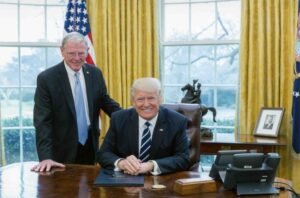Trump Calls For Arms Control, Rips Own Defense Budget As “Crazy”
Posted on
WASHINGTON: President Donald Trump injected a fresh dose of uncertainty over defense spending Monday when he derided 2019’s defense budget — which he readily signed and has praised for months — as “Crazy!”
The sharp turn in sentiment came in another dreaded early-morning presidential tweet that often shift the talking points for entire segments of the federal government, even if policies don’t change drastically.
I am certain that, at some time in the future, President Xi and I, together with President Putin of Russia, will start talking about a meaningful halt to what has become a major and uncontrollable Arms Race. The U.S. spent 716 Billion Dollars this year. Crazy!
— Donald J. Trump (@realDonaldTrump) December 3, 2018
The latest presidential missive was part of the president’s upbeat appraisal of his own performance at the G20 summit in Argentina over the weekend, where he met with Chinese president Xi Jinping and had an informal talk with Russian leader Vladimir Putin. Back in Washington, Trump wrote he is certain the three can “start talking about a meaningful halt to what has become a major and uncontrollable Arms Race. The U.S. spent 716 Billion Dollars this year. Crazy!”
Trump has spent months calling attention to the size of the defense budget as proof that he is building a more formidable military, often complaining that previous administrations didn’t spend enough on defense.
Signing the $716 billion bill in August, the president proclaimed, “after years of devastating cuts, we’re now rebuilding our military like we never have before.” Introducing the president at the signing ceremony at Fort Drum, headquarters of the 10th Mountain Division, Vice President Mike Pence said that under Trump, “the days of arbitrary budget cuts to our national defense are over.”
But just over a month ago, Deputy Defense Secretary Patrick Shanahan revealed that Office of Management and Budget director Mick Mulvaney ordered him to cut $33 billion from the planned $733 billion defense budget the Pentagon had built for 2020, a last-minute reduction that the Pentagon has been scrambling to meet in the weeks since.
The details of the new budget have yet to be released, but many predict that planned modernization programs will be the bill payers.
“Because this came so late in the planning process, all the personnel costs are cooked,” Shanahan’s predecessor Robert Work said over the weekend at the Reagan Defense Forum in Simi Valley, California. “All the operations and maintenance money is set. So you have to go into modernization to find the money.”
While a $700 billion defense bill is still a massive amount of money, given the plans to grow the force and increase the pace of modernization, “this becomes a real cut,” Work said.
The Pentagon is slated to bring its revised budget to the White House early this month for the president’s sign-off before it is submitted to Congress in February, and it remains unclear how Defense Secretary Jim Mattis will revise his overall strategy given the smaller number.
Speaking at the Reagan Forum over the weekend, Mattis dismissed concerns over budget uncertainty, calling the five percent cut part of “the normal give and take of building the president’s budget.” He appeared to hold out for a number bigger than $700 billion, adding, “I would just tell you that the issue is in play, and I’ll give my advice to the president.”
On the sidelines of the event, Alan Estevez, former deputy under secretary for acquisition, technology and logistics told me that the $716 billion budget was likely “the high water mark,” for defense spending, but he expects the final number in 2020 to come closer to that level than to $700 billion, making budget growth flat.
Republican leaders in Congress have already come out against the flatlining budget. Last week, in a Wall Street Journal editorial titled “Don’t cut military spending, Mr. President,” Rep. Mac Thornberry and Sen. Jim Inhofe argued that while reducing defense spending by five percent won’t impact the national deficit, “any cut in the defense budget would be a senseless step backward” while hurting the Pentagon’s drive to keep ahead of China and Russia.
Adding another degree of uncertainty over the upcoming budget season is the takeover of the House by Democrats, who will likely relish the oversight they can conduct of the Pentagon.
It’s unclear what changes a Democratic House will hold for the defense budget, as many members support robust defense spending and have so far not called for major cuts. Many expect Democrats to agree to higher defense numbers if they can make a deal to get around the Budget Control Act and gain assurances for increases in domestic spending.
“We might all like to think we can get a budget for defense separate from other things in the government, but I don’t think that’s going to happen,” Democratic Sen. Jeanne Shaheen said in California over the weekend. “We’re not just talking about the defense budget, we’re talking about the whole government.”
Speaking on the sidelines of the Reagan Forum, the likely incoming chairman of the House Armed Services Committee, Adam Smith, told me that his “priorities are to get a budget deal so we can get numbers.” And then debate over where those budget numbers go can begin.
“Having a consistent number so you eliminate the uncertainty is important,” Smith said.
A longtime critic of plans to spend $1.2 trillion on modernizing the nuclear triad in the coming years, Smith told me that “we have to modernize our nuclear weapons — I recognize that — but I don’t think we have to spend $1.2 trillion dollars. I think there’s money to be saved there.”
The lawmaker also said he thinks there are savings in modernization as opposed to updating old weapons systems. He pointed out that he’s interested in studying if “there’s money to be saved by looking at technology, cyber, and space — looking at the warfare of the future as opposed to legacy systems.”
Smith’s critique of the triad dovetails in some respects with President Trump’s call to halt the “arms race” with Russia and China. But the president’s call for arms control comes just a month after he threatened precisely those two countries with just such a contest.
“Until people come to their senses, we will build it up,” Trump said, referring to the US nuclear stockpile. “It’s a threat to whoever you want. And it includes China, and it includes Russia, and it includes anybody else that wants to play that game. You can’t do that. You can’t play that game on me.”
Subscribe to our newsletter
Promotions, new products and sales. Directly to your inbox.



